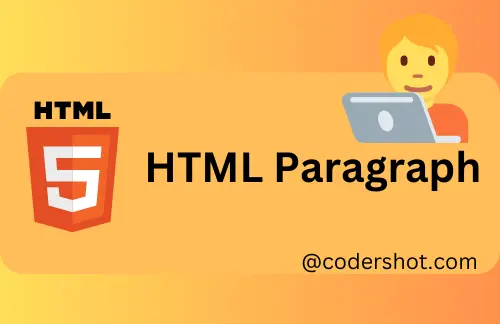Table of Contents
ToggleHTML PARAGRAPHS
Understanding HTML Paragraphs: A Beginner’s Guide
Paragraphs are one of the most important building blocks of HTML (Hypertext Markup Language), which is the foundation of every webpage. We will go into great detail about HTML paragraphs in this blog article, including their functions and useful applications for organizing web content.

An HTML Paragraph: what is it?
HTML uses the <p> tag to define paragraphs. Dividing ideas or informational portions into separate tags, this tag allows the break up of long text blocks and makes content easier to read. A <p> beginning tag and a </p> ending tag enclose each paragraph.
Syntax:
<p> This is my first paragraph. </p>
This code will be shown as a text block in a web browser, separated from other elements by space above and below.
Features Of HTML Paragraphs
1. Block-level Element: begins on a new line and occupies the entire width.
2. Automatic Spacing: Paragraphs are automatically padded by browsers.
3. Text Wrapping: The paragraph’s text automatically wraps around itself.
4. Non-Block-level Nesting: Unable to include more block-level components.
5. CSS Styling: CSS makes customization simple.
Some Tags Used In HTML Paragraphs
The <pre> tag:
To show preformatted text in HTML, use the tag. Text enclosed in elements is shown precisely as it exists in the HTML source, with a fixed-width font that maintains line breaks and spaces.
Syntax:
<pre>-----content you want-----</pre>The <br> Tag:
A new line is created without the beginning of a new paragraph using the HTML’s <br>tag element. <br> is used to transition to the following line without starting a new paragraph.
Syntax:
<br>----write you content---The <hr> Tag:
A horizontal rule or line is created by the HTML <hr> tag to visually divide information on a webpage. To add a horizontal line that clearly defines a gap in the page’s visual design between sections or parts, use <hr>.
Syntax:
<hr>NOTE*: <br> and <hr> tags have no closing or ending tag. They are open tags.
Examples Of HTML Paragraphs
Example 1:
<!DOCTYPE html>
<html>
<body>
<h1>CODERSHOT</h1>
<p>
<pre>
Preformatted text's first line.
Preformatted text's second line.
</pre>
<br>
This follows preformatted text with a line break.
<hr>
The rule that follows the line break is horizontal.
</p>
</body>
</html>
Output:

Example 2:
<!DOCTYPE html>
<html lang="en">
<head>
<meta charset="UTF-8">
<meta name="viewport"
content="width=device-width, initial-scale=1.0">
<title>HTML paragraphs </title>
<style>
pre{
background-color:lightcyan;
}
</style>
</head>
<body>
<pre>
This paragraph is made up of several lines.
Nevertheless, unlike the paragraph tag,
it is shown as is.
</pre>
<hr>
<pre>
This paragraph is made up of several lines.
Nevertheless, unlike the paragraph tag,
it is shown as is.
</pre>
</body>
</html>
Output:

Conclusion
Paragraphs in HTML are essential to the organization of web content. They ensure that users can readily ingest the text, enhance readability, and aid in the clear organization of information. It is possible to improve your webpage’s usability and aesthetic appeal by comprehending the fundamentals and using a few best practices.
HTML Paragraphs-FAQS
- Are <p> tags nested within <p> tags?
No, nested <p> tags are not allowed and may result in problems with rendering. To nest, use other block elements.
2. When <p> tags are positioned inside inline components such as <a>, What happens?
This is not acceptable HTML, and its rendering may be erratic. Use of <p>is restricted to block-level elements.
READ ALSO: Learn about HTML Attributes.







